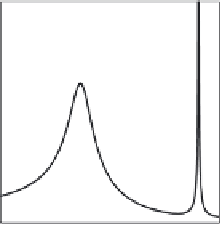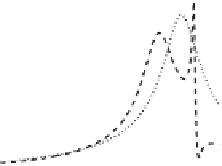Geoscience Reference
In-Depth Information
1
150
0.8
0.6
100
0.4
50
0.2
0
0
3
3.5
4
3
3.5
4
L
−
shell
L
−
shell
Fig. 6.11.
The calculated amplitude (a)
|b
ϕ
|
and phase (b) arg(
b
ϕ
) of the azimuthal
magnetic component vs.
L
(see (6.88) and (6.90)) for the 1-st harmonics in the
vicinity of the resonance magnetic shell. The solid lines represent
T
1
= 120 s, the
dashed lines -
T
2
= 160s, and the dotted lines -
T
3
= 180
.
2s
the driver period exceeds maximal FLR-period, the amplitude distribution
also has one maximum gradually flattened with increase of
T
. Such ampli-
tude distribution for the driver period
T
3
= max
T
1
(
L
) is shown by the dotted
line in Fig. 6.11a.
If the FLR-shells are distant from each other, the phase jumps at
180
◦
as each of the FLR-shell transections. The sign '+' is taken for the FLR-
period growth in passage of the resonance shell, and '
≈±
' is for the FLR-
period diminution. The solid line in Fig. 6.11b demonstrates such L-phase
dependency. The phase decreases at
−
180
◦
with an increase of
L
from 3 to
3
.
5 and increases at 180
◦
for a change of
L
from 3
.
8 to 4. As a result the total
phase change at the consequent passage of two resonance shells is
≈
0
◦
.
The mutual contribution of two close resonances with different excitation
coecients
Λ
Bj
to the total magnetic field. The dashed line in Fig. 6.10b
presents an example of the phase
L
-distribution in the vicinity of the two
FLR-shells. Close to the first shell with
L
1
=3
.
73 the phase rapidly goes
down almost at 180
◦
and near the second shell,
L
2
=3
.
88, the phase initially
increases. An impact of
L
1
prevails with moving away from
L
2
to the north.
As a consequence, the total phase change
≈
180
◦
as
L
changesfrom3to4.
Approaching the FLR-shells, the phase change becomes monotonous and has
the form shown by the dotted line in Fig. 6.11a for the drive period
T
3
.
≈−
Meridional Distribution of the FLR Polarization Ellipses
Let us note some features of the FLR-polarization above the ionosphere. A
polarization ellipse is defined by the ratio of the meridional component
b
ν
to
the azimuthal component
b
ϕ
. From (6.89), (6.90) we get
b
ν
b
ϕ
≈
imξ
ln(
−
imξ
)
,












Search WWH ::

Custom Search